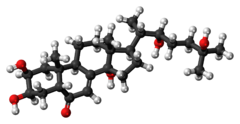Ecdysone

| |

| |
| Names | |
|---|---|
| IUPAC name
(2S,3R,5R,9R,10R,13R,14S,17R)-17- [(2S,3R)-3,6-dihydroxy-6-methylheptan- 2-yl]-2,3,14-trihydroxy-10,13-dimethyl- 2,3,4,5,9,11,12,15,16,17-decahydro- 1H-cyclopenta[a]phenanthren-6-one
| |
| Identifiers | |
3D model (JSmol)
|
|
| ChEBI | |
| ChEMBL | |
| ChemSpider | |
| ECHA InfoCard | 100.020.692 |
PubChem CID
|
|
CompTox Dashboard (EPA)
|
|
| |
| |
| Properties | |
| C27H44O6 | |
| Molar mass | 464.63 g/mol |
Except where otherwise noted, data are given for materials in their standard state (at 25 °C [77 °F], 100 kPa).
| |
Ecdysone is a steroidal prohormone of the major insect molting hormone 20-hydroxyecdysone, which is secreted from the prothoracic glands. Insect molting hormones (ecdysone and its homologues) are generally called ecdysteroids. Ecdysteroids act as moulting hormones of arthropods but also occur in other related phyla where they can play different roles. In Drosophila melanogaster, an increase in ecdysone concentration induces the expression of genes coding for proteins that the larva requires, and it causes chromosome puffs (sites of high expression) to form in polytene chromosomes. Ecdysteroids also appear in many plants mostly as a protection agent (toxins or antifeedants) against herbivorous insects. These phytoecdysteroids have been reputed to have medicinal value and are part of herbal adaptogenic remedies like Cordyceps, yet an ecdysteroid precursor in plants has been shown to have cytotoxic properties.[1] A pesticide sold with the name MIMIC has ecdysteroid activity, although its chemical structure has little resemblance to the ecdysteroids.
See also
- Ecdysone receptor
- PTTH - Metamorphosis Initiator hormone
External links
- Ecdybase, The Ecdysone Handbook - a free online ecdysteroids database
Notes
- ^ Wang YS, Yang JH, Luo SD, Zhang HB, Li L, Molecules. 2007;12(3):536-42
